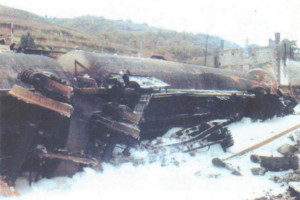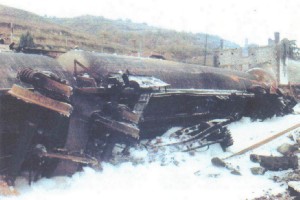A 22-railcar convoy derailed at 11:50 pm in a small town of 2,000 residents; 9 tanks carrying 80 m³ of unleaded fuel spilled, ignited and exploded. This burning gasoline consumed dwellings and reached the sewer system. Electricity had to be shut off and vehicle traffic diverted. The fire was brought under control by 6:30 am on the 4th following the intervention of 180 fire-fighters equipped with separate resources (e.g. motor-driven pumps).
A village resident was injured, 34 others housed elsewhere. The accident zone extended over 1 km strip 400 m wide; 8 dwellings, 2 garages and 30 cars were destroyed, and another 5 houses were damaged. 250 to 300 m³ of gasoline polluted 2 ha of ground. Potable water extraction zones were threatened 100 m away and “gas” smells were reported on several nearby properties. The use of agricultural wells was prohibited, water pumping was restricted, and fruits and vegetables ruled unfit for consumption within a 12.5-ha zone. The affected dwellings were demolished.
A pollution cleanup firm was intervened ; 10% to 20% of the hydrocarbons (HC) were combusted or had evaporated, while 80% to 90% of gaseous or liquid HC were trapped in the soil layers above the water table (i.e. “unsaturated zone”), both in the rail embankment and at the surface of the water table within a thin clayey formation at the base of a hillside. The shafts and caverns were cleaned. The polluted zones were treated with water table drawdown (16 m³/hr via 3 pumping stations), reduction of the polluted zone by characterising the subsoil and contamination (an expert body, 40 boreholes), then a 3-stage cleanup:
- pumping/skimming of the water table: 40 m³ of HC recovered during a 17-month period, with discharge into the Rhone River of all drawdown water containing less than 20 parts per million (ppm) of HC;
- bioleaching testing, through probing in vain beyond 2 m of depth, this stage would be abandoned;
- highly efficient vacuum extraction (venting), giving rise to a call for tender with quantifiable objectives: HC content of soils no greater than 10 ppm, absence of HC supernatant in the water table following 1 year of cleanup.
After 45 weeks of treatment, 210 m³ of HC were extracted from the parcels not returned to their owners, but instead expropriated by the municipality for public facilities, thus simplifying the adoption of soil/subsoil use restrictions included in land use planning documents, in order to guarantee a long-term use allocation compatible with the presence of residual pollution.
The public investigation pointed to excessive train speed (93 km/hr) with respect to the defect (“warping”) of rail track, whose foundation was weakened subsequent to heavy rains. For the railway operator, the cost of this accident amounted to 28 MF (1991 currency) in emergency measures, studies/pollution cleanup of the site, plus another 22 MF in compensation (third-party losses / municipality).
After the initial emergency response, the municipality, railway company and administrative authorities had to make quick decisions to assess the actual/potential extension and consequences of the pollution, before implementing suitable measures aimed at preventing propagation, without the time to estimate their duration/costs in the absence of clearly-defined lines of responsibility.
This vacuum extraction, or venting, technique was again used a few months later following another accident on this same section of track 100 km further south (ARIA 4225). The bioleaching tests demonstrated that the pollution cleanup technique depends on both the pollutants and the target media, i.e. type of soils, permeability, water table depth, flow velocity.
As regards feedback applicable to classified facilities, the potential consequences of this kind of accident imply the emergency use of resources in order to contain flow, before implementing other resources to evaluate and absorb the pollution. The massive, uncontrolled spreading of flammable liquids could generate high risks, especially during network flows (e.g. ATEX Directive). Such situations need to be taken into consideration when drafting safety reports and emergency plans.
Download the detailed report in .pdf format (224 Kb)





